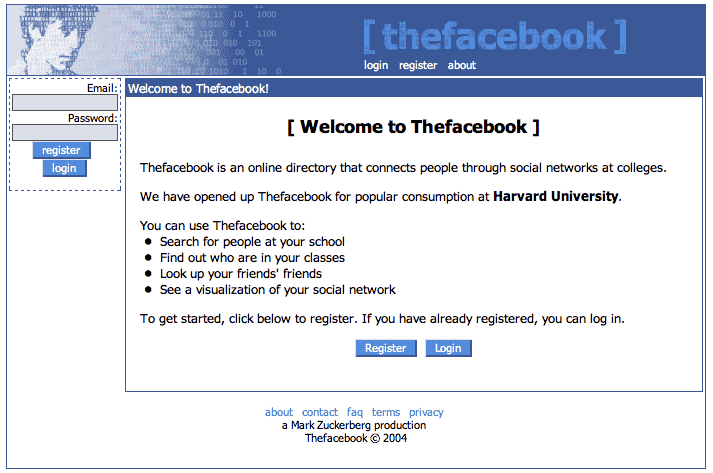Facebook has been going through changes since day one, and every time an upgrade is released the walls and news feeds of the most popular social network in the world become saturated with complaints. I am constantly begging people to stop complaining and embrace the changes that Facebook continues to make. I mean, lets be real, if Facebook never made any changes, many of you wouldn’t be allowed to access the site, and it would still look like this:

Yuck! I have to give props to the Zuckerberg for coming up with the idea (well, implementing it) but the original design and function of the site are far different from what over 750 million users see today. Imagine if Facebook responded every time a user complained about how difficult it is to get used to the new format, or the new news feed. This is what we would be stuck with, and I would have logged out a long time ago.
So, what are the newest changes to Facebook? The biggest change that you will notice is your news feed. The new news feed is organized a little differently, and no longer lets you toggle between “top stories” and “most recent”. Instead, your news feed will automatically be organized with Top Stories at the top, and Recent Stories feeding in below them.
Facebook describes Top Stories as:
“We determine whether something is a top story based on lots of factors, including your relationship to the person who posted the story, how many comments and likes it got, what type of story it is, etc. For example, a friend’s status update that might not normally be a top story may become a top story after many other friends comment on it.”
This is actually a pretty accurate explanation of EdgeRank, Facebook’s algorithm for determining what shows up where. If your Facebook page has a low EdgeRank, your status updates and any other uploaded content will not show up on all news feeds (more on this later). This change in the news feed was made to help organize the content you want to see, depending on how often you log on. If you log on to Facebook once a week, Top Stories from the past week will appear at the top of your news feed, making sure you don’t miss any interaction between your friends, family and favorite pages. If you frequent Facebook several times a day, you probably wont see much fall under Top Stories, because Facebook knows that you have already checked them out.
Facebook explains:
“it’s not just the people you hear from that make your News Feed interesting. It also matters how much you visit Facebook. If you haven’t returned in a week, you may want to see a summary of top stories first. If you’ve already visited several times that day, you probably care more about recent news.”
So for those of you who only frequent Facebook once a week or so, you no longer have to worry about missing important stuff. If you frequent Facebook often, you will see Recent Stories first, since chances are good that you have already seen or interacted with the Top Stories.
EdgeRank
EdgeRank is a score that your Facebook page earns, which results from a complicated algorithm that Facebook is in no hurry to share. Most of the criteria centers around engagement. The more fans your page has the better, but there are several other factors. Do your fans interact with your content? Do they post photos, comment on your wall, like your comments? This is why you may have noticed that certain friends appear in your news feed more than others, even though both utilize Facebook the same way. If you interact with a friends content, view their photos, like their comments, and message back and forth with them, you will see many more updates from that friend than you would someone you rarely interact with. EdgeRank is Facebook’s way of deciding what they think is important to you.
While EdgeRank also used to have everything to do with the “top stories” tab at the top of the news feed, and is still very relevant, you are no longer able to simply switch it off. In the past you could choose whether you wanted to view “most recent” updates, or “top stories” by toggling the tab at the top of the news feed on and off. Now, if you haven’t seen your Facebook wall in several hours (Facebook knows, trust me) you will have no choice but to be exposed to Top Stories before you scroll down to the Recent Stories.
This is why many Facebook marketers are considering EdgeRank to be more important than ever. Content with high EdgeRank will now appear in the coveted Top Stories segment of the news feed, and will have more durability than ever before. What I mean by durability is, in the past if a post went unnoticed for more than a few hours, it is pretty likely that you would never see it with a constant stream of content feeding in on top of it. Now, if you maintain a high EdgeRank, your posts may become much more “sticky” and can appear in the Top Stories section for days – depending on who’s news feed it is.
More Changes
Some of the other changes that I have recently noticed seem to have come straight from competing social networks Google+ and Twitter. The “subscribe” button is much closer to “following” somebody on Twitter than it is to “friending” somebody on Facebook. The “improved friends lists” seem to be strikingly similar to Google+’s circles. While these are both important and useful updates, it looks as though Facebook is trying pretty hard to keep it’s crown as king of all social content on the web.
The “subscribe” button allows you to further customize what content is being fed to you. You will notice the button at the top right of a profile page. When you subscribe to a person, you can choose to get all updates, no updates, or some updates depending on the topic. If you want to maintain and social relationship with one of your “friends”, but don’t want to be updated on what they had for breakfast, lunch and dinner, and what they did in between, just “unsubscribe”. If a Facebook profile allows subscribers, you do not need to be “friends” with them to subscribe. This is very similar to the way Twitter works, where you either “follow” or “unfollow” friends, celebrities, industry experts & news sources depending on what you’re interested in.
The new and improved “friends lists” allow a Facebook user to sort their friends, and control who they are broadcasting content to. Friends lists have existed for years, but Facebook now offers you smart lists to save you the time of organizing all of your friends. The smart lists include: Work, School, Family, and City, which Facebook likely knows based on your profile information. You can also place certain friends on a restricted list, so that they will only see your Public Posts. By using lists, you can control where the content that you are reading comes from, as well as where your own content ends up.
This is remarkably similar to Circles, which Google+ describe as:
“Google+ Circles helps you organize everyone according to your real-life social connections–say, ‘family,’ ‘work friends,’ ‘music buddies,’ and ‘alumni’. Then, you can share relevant content with the right people, and follow content posted by people you find interesting. For example, you might post an announcement about your engagement and show it only to people in your friends and family circles, or maybe you see a post from the circle you created for your book club that there’s a recent article on your favorite author.”
Even more changes are coming to Facebook, and will continue to come. I am sitting here watching the f8 development conference as I write this post, and I am seeing that there are so many people on Facebook, and the connections are already all made. So Facebook will now start rolling out apps that enhance usability and your overall social experience. One of the newest, and coolest, updates in my opinion is the Timeline. Soon, Facebook will release the Timeline, that will let you go back and look at your entire story, since your first status update. The Timeline will let you scroll through the years, and check out photos, stories, places, etc.. Mark Zuckerberg just showed us that the Timeline even has a function that allows you to track your locations over the years, forming a world map showing all the places where you have checked in.
Facebook is going to continue rolling out updates and new social apps in the future. While the massively popular social media site is constantly asking it’s users to learn how to use new additions and updates, these updates are essential to the progression of social media itself. Even industry experts are learning this stuff as they go! There are no textbooks, or history lessons that people learn from. The entire industry changes every day! Facebook is not spending all of their time and money studying the competition and emulating their devices. They are innovators. They are engineering new ways for people to share, interact and socialize all over the globe.
So next time a new update is released for Facebook, take a minute to check it out and learn what it’s about before bashing the Zuckerberg on your Facebook wall. He (or another Facebook exec.) might hear what you are saying, but nothing is going to stop Facebook from progressively changing and discovering new ways for people to interact online. And lets face it, 750 million users are not going to just give up on the king of social media.


